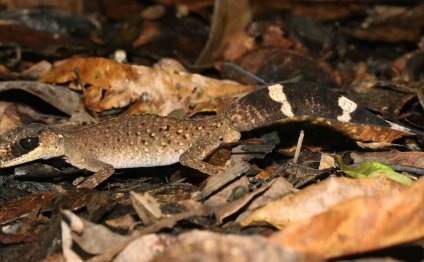
Pet Gecko species
| Species Profile: Leopard Gecko | |
| Scientific Name: | Eublepharis macularius |
| Natural Environment: | Southern Asia (Pakistan to Northwest India) |
| Average Size: | 6" - 9" long; the males have a slightly larger, heavier build than the females. |
| Average Life Span: | 15 to 20 years, though some have lived up to 30 years. |
| Appearance: | The Leopard Gecko has small, knob-like bumps over its entire body that give it the appearance of being very rough. However, its skin is actually soft to the touch. It has a triangular head and, when healthy, a large fat tail. The tail is where the Leopard Gecko stores its fat and is usually indicative of the gecko's health.
The Leopard Gecko is generally leucistic (no color) or pale yellow with dark brown spots. Young Leopard Geckos start out with alternating bands of color that develop into spots or splotches as they age. There are, however, many different Leopard Gecko color morphs. Some of the most common color variations include yellow, brown, white, and leucistic (with black eyes). |
| Habitat | |
| Size: | A 10-gallon terrarium is sufficient for one Leopard Gecko. Two Leopard Geckos would need a 15-gallon terrarium, and three would need a 20-gallon terrarium. The terrarium should be long and shallow because Leopard Geckos don't climb very well. |
| Lighting: | Leopard Geckos are nocturnal, so UV lighting is not essential. Red bulbs (day or night), black bulbs (day or night) or ceramic heaters can be used to provide heat or for nighttime viewing. Bright white or daytime lights can stress your Leopard Gecko and should not be used. |
| Temperature: | Keep the tank at 80° to 85°F during the day with a basking area (directly under the light bulb) of 90°F. At night, the tank temperature should be in the 70's. Under tank heaters (UTH) are the preferred method of heating Leopard Gecko habitats because they warm the environment from the bottom of the substrate up.
The terrarium should have a temperature gradient with a 10°F variance. The cool end of the gradient should fall into the 70's to low 80's and the warm end of the gradient should rise between 80° to 90°F. Leopard Geckos will use the temperature gradient to regulate their body temperature by moving from one side of the temperature gradient to the other. |
| Humidity: | Leopard Geckos need a humidity of approximately 40% to 60% to encourage proper shedding. If the humidity is too low, place moist peat moss in a hide box or shelter, and mist it periodically. |
| Housing: | This species does not climb very well, but you must provide a number of hiding spots, such as hideboxes with small openings and caves, for its daytime periods. Rocks and logs should be added to the terrarium to provide places for exercise. Leopard Geckos can be kept in groups of two or three, but there should only be one male per terrarium, as male Leopard Geckos are extremely territorial. |
| Substrate: | Artificial turf, paper toweling, slate tile, newspaper, commercial terrarium sand substrates, or commercial terrarium clay substrates. |
| Diet/Feeding: | The... |
Share this Post
Related posts
Colorful lizard
A very large species of chameleon that is endemic to forests in eastern and northern Madagascar. They reach up to 68 cm (27…
Read MorePet geckos types
Geckos make excellent pets. Images While not all species of geckos are good candidates for pet ownership, there are many…
Read More











